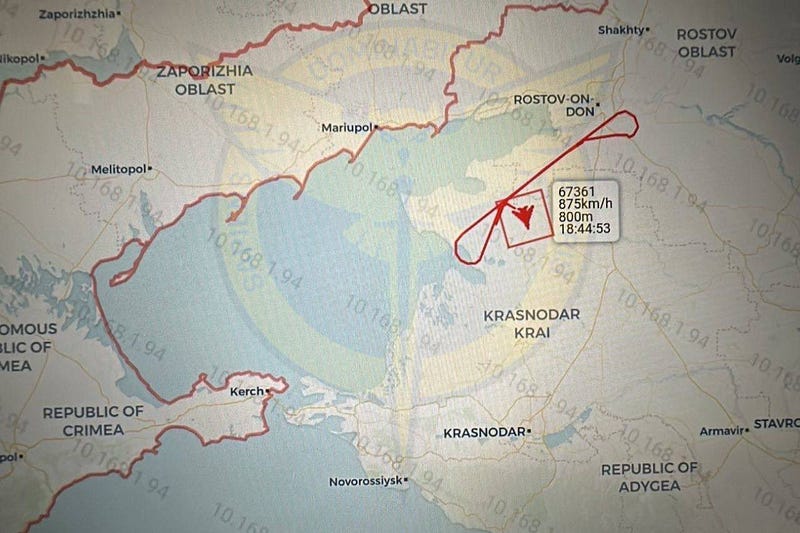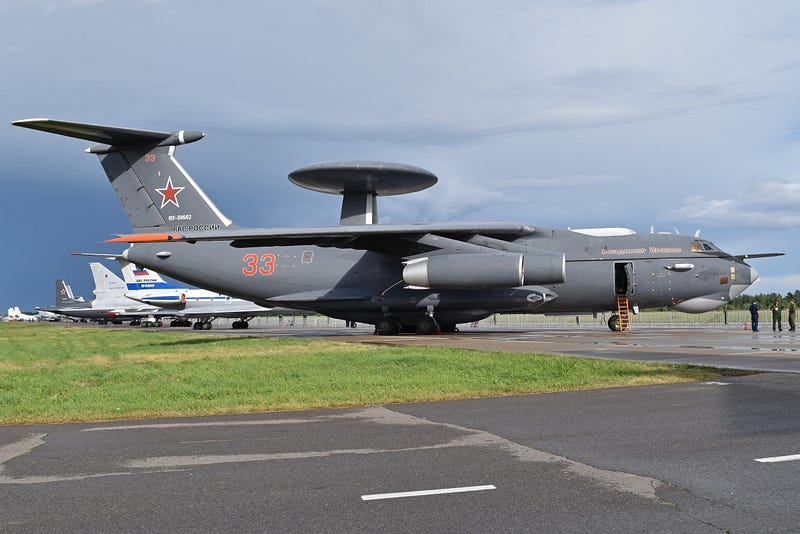Ukraine Downs a Second A-50 in a Bold Strike Two Years into the War!

Two years into “Operation Z,” the downing of two Beriev A-50 AWACS radar aircraft by Ukraine has exposed significant vulnerabilities in Russia’s air defense capabilities. The A-50U, crucial for coordinating all aerial operations over Ukraine, was hit over 170 kilometers from the frontline, marking a substantial loss for Russia, which had only six modernized units at the invasion’s outset. The destruction of these aircraft, each valued at around $330 million, signals a significant shift in the conflict’s dynamics, emphasizing Ukraine’s ability to challenge Russian air superiority effectively.
The incident involving the A-50U shot down on February 23, over Russian airspace east of the Azov Sea in the Krasnodar region, and the subsequent finding of 10 crew members’ bodies underscores the escalating costs of this conflict for Russia. The downing occurred far beyond the stated maximum range of AIM-120D missiles, hinting at the possible deployment of F-16s in Ukraine sooner than anticipated. This loss, coupled with the downing of a Russian Su-34 fighter-bomber over the Kherson region, further illustrates the increasing pressure on Russian air operations and raises questions about the effectiveness of Russia’s military strategy and the potential early arrival of advanced Western aircraft to the Ukrainian theater.
The narrative of Ukraine’s survival and strategic victories against Russia has been a consistent theme throughout the conflict. Despite initial doubts about Ukraine’s ability to withstand the Russian invasion, the Ukrainian forces have not only survived but also managed to inflict significant damage on the Russian military. The destruction of 20% of Russia’s Black Sea Fleet, including the Moskva cruiser, and the downing of two modern A-50 aircraft, highlight Ukraine’s resilience and tactical ingenuity. These accomplishments challenge the perception of Russia’s military invincibility and demonstrate the effectiveness of Ukrainian defenses.
A quick heads-up: Medium’s been tweaking its algorithms and it’s getting trickier for my stories to land in your feed. So, if you enjoy my work, please make some noise! Hit that clap button, light up the highlights, or drop a comment. Every interaction helps keep the stories flowing. Thanks for your support!
The Russian military’s response to these setbacks, characterized by a mixture of denial and propaganda, aims to demoralize the Ukrainian resistance and reassure the Russian populace of their military’s supremacy. However, these efforts cannot conceal the operational realities and losses experienced by Russian forces in the field. The destruction of the A-50s not only represents a tactical loss but also a blow to the image of an indomitable Russian military force projected by Putin.

Speculation about the types of missiles supplied to Ukraine, such as the possible provision of the Meteor air-to-air missile by the UK, reflects the evolving nature of military support for Ukraine. This support has enhanced Ukraine’s defensive capabilities, enabling it to challenge Russian air dominance more effectively. The loss of Russian AWACS aircraft, critical for air reconnaissance and coordination, significantly impacts Russia’s operational capabilities in the region, limiting its ability to conduct comprehensive air operations over Ukraine.
As the conflict enters its third year, the resilience of Ukrainian forces continues to defy expectations, demonstrating a remarkable capacity to adapt and counter a technologically superior adversary. The strategic setbacks experienced by Russia, highlighted by the loss of key air assets and the failure to demoralize the Ukrainian spirit, underscore the complexity of modern warfare and the pivotal role of international support in shaping the conflict’s outcome. Ukraine’s ongoing resistance and strategic victories over Russian forces not only alter the tactical balance on the ground but also challenge the narrative of Russian military invincibility, marking a significant phase in the conflict’s evolution.
The downing of Russian AWACS planes, notably the A-50U over the Azov Sea, marks a critical juncture in the Ukraine-Russia conflict, demonstrating Ukraine’s growing capability to counter Russian air dominance. The significance of these losses extends beyond the immediate tactical setbacks for Russia; it reshapes the strategic landscape of the conflict and challenges the long-held perceptions of Russian military invulnerability. The successful targeting of these aircraft, essential for air command and control, signifies a notable enhancement in Ukrainian air defense capabilities, likely augmented by Western technology and intelligence support.

The implications of these developments are profound. The A-50's loss, a platform that provided comprehensive surveillance and coordination for Russian air operations, severely hampers Russia’s ability to execute coordinated air strikes and maintain aerial surveillance over the vast expanse of the conflict zone. With only a few of these aircraft remaining operational, Russia’s tactical flexibility and operational reach are significantly curtailed. This setback occurs against the backdrop of Ukraine’s demonstrated ability to strike high-value targets deep within contested airspace, suggesting an increasing sophistication in Ukraine’s air defense strategy and a possible preemptive capability against Russian air operations.
The strategic blunder of losing such valuable assets has sparked a mix of acknowledgment and obfuscation within Russia. Military bloggers and official sources have engaged in a blame game, pointing fingers at Russian air defenses while simultaneously downplaying the effectiveness of Ukrainian forces. This narrative manipulation reflects a broader strategy to maintain the facade of Russian military superiority and to mitigate the impact of such losses on domestic morale and international perceptions. However, the reality on the ground and in the skies above the conflict zone tells a different story – one of increasing Ukrainian resilience and capability.
The broader geopolitical ramifications of these events cannot be overstated. The downing of the A-50U, coupled with other recent losses, sends a clear signal to the international community about the changing dynamics of the conflict. It underscores the effectiveness of Western military aid to Ukraine, raising questions about the future of international support and the potential escalation of military assistance, including the provision of more advanced systems and platforms. This development also challenges Russia’s strategic posture in the region, potentially forcing a recalibration of its military strategy and objectives in Ukraine.

Moreover, the incident shines a light on the internal challenges facing Russia, from the sustainability of its military operations to the impact of international sanctions and the reliance on asymmetric tactics and misinformation. The economic underpinnings of Russia’s war effort, characterized by an increasing dependency on Chinese markets and the clandestine acquisition of Western technology, reveal the vulnerabilities of a military juggernaut struggling to maintain its operational tempo and technological edge.
In conclusion, the destruction of Russia’s A-50 AWACS aircraft represents more than a tactical setback; it symbolizes a significant shift in the Ukraine-Russia war’s dynamics. It highlights the resilience and strategic ingenuity of Ukrainian forces, the critical role of international military support, and the emerging challenges to Russian military strategy and geopolitical ambitions. As the conflict evolves, the lessons drawn from these incidents will undoubtedly influence the strategic calculations of all involved parties, reshaping the contours of the conflict and the broader geopolitical landscape in which it unfolds.
